Baltimore Orioles: How the Orioles and the Royals match up against MLB history’s bad teams

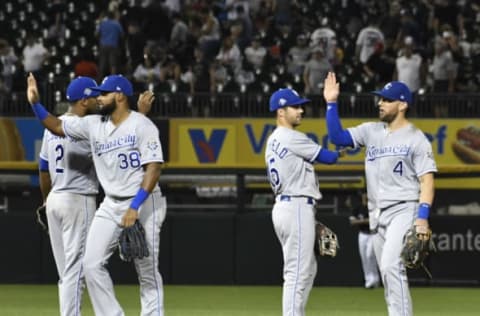
With a .296 winning percentage, the Baltimore Orioles are on pace to lose 114 games. At 38-87, the Kansas City Royals aren’t doing much better. Could their seasons make long-term MLB history for futility?</h2
These are historically terrible seasons. Only one team in the past half-century has lost 70 percent of its games, yet both the Baltimore Orioles and Kansas City Royals could do that in 2018.
Baltimore would have to finish 12-25 in its final 37 games to avoid a .296 (or worse) winning percentage. That may not sound all that difficult, except that the Orioles are 37-88 for a reason. Their longest winning streak all season is four games, and they haven’t done that since May. Beyond that, they have eight losing streaks of five games or longer.
The Baltimore Orioles Pythagorean record – a calculation of what their record ought to be based on their totals of runs scored and runs allowed – is seven games better than their actual record. That means they’ve not only been bad, they’ve also been unlucky.
The final fact operating against their chances down the stretch is their trade-deadline unloading of several of the team’s stars, notably Manny Machado, Zach Britton, Jonathan Schoop, Darren O’Day, and Kevin Gausman. In place of Schoop and Machado, journeymen Jace Peterson and Jonathan Villar are holding down the middle infield while rookie Yefry Ramirez, with his 6.49 ERA, gets Gausman’s starts.
The Royals underwent less of a deadline-driven talent exodus than the Baltimore Orioles – arguably because there was less talent on hand to start with — but they did trade away third baseman Mike Moustakas, a key figure in the 2015 World Series winners. Still, they’ve won just two games more over their most recent 37 games than they need to stay above .300. Their longest win streak is just three games, and like the Orioles, you have to go back to May to find that streak.
Although the Baltimore Orioles and Royals are on pace to be considered among the historically wretched, their stench is not unprecedented. For perspective and comparison, let’s take a look at some of baseball’s historically bad teams, one per decade.
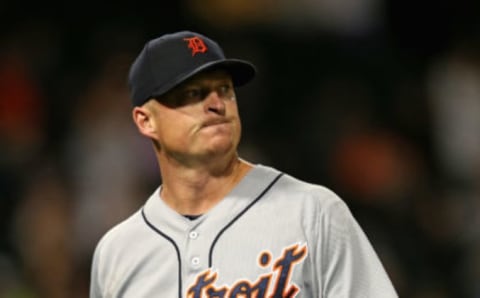
2003 Detroit Tigers (43-119, .265)
The worst team in Tigers franchise history lost its first nine games, 25 of its first 28, and eventually finished 47 games behind the division champion Twins. The Tigers lost 40 games by five or more runs and on 21 different occasions allowed 10 or more runs.
Under general manager Dave Dombrowski and field manager Alan Trammell, the Tigers were a team in extreme transition. Within three seasons, they would win 95 games and reach the World Series. Most of their 2003 talent would, though, be long gone by then. Only pitcher Jeremy Bonderman, outfielder Craig Monroe and infielder Brandon Inge played prominent roles on both teams. Trammell was gone as well, replaced following a 71-91 2005 season by veteran Jim Leyland.
For 2003, though, that rosy future was hard to envision. The Tigers batted a league-low .240, 14 points below the next worst figure, and averaged just 3.65 runs per game, more than a full run below the league average. Tiger batters struck out 1,099 times in 2003, an average of nearly 7 per game; the AL average was a fraction above 6.
Only the Texas Rangers had a worse staff ERA than Detroit’s 5.73. The Tigers also committed the most errors and racked up the league’s worst fielding percentage. In April, again in June, a third time in August and a final time in September, the Tigers lost nine or more games in succession.
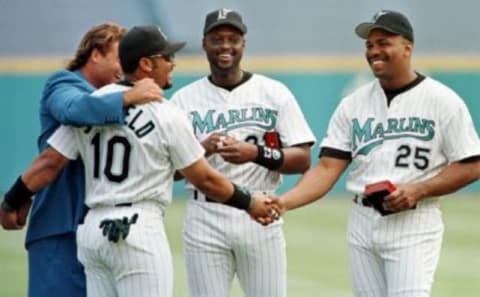
1998 Florida Marlins (54-108, .333)
The strange tale of the defending World Series champions began with owner Wayne Huizenga’s decision to cash in on his team’s winnings and get out of baseball. To Huizenga, that meant first cannibalizing Florida’s personnel assets in order to make the Marlins more attractive to a potential purchaser.
The breakup began with the trade a few days following the team’s world championship celebration of outfielder Moises Alou. Within a week, outfielders Jeff Conine, Devon White and Randy Winn plus catcher Darren Daulton and reliever Robb Nen were gone. Mound aces Kevin Brown and Al Leiter followed over the winter. Then during a single week in May, Marlins GM Dave Dombrowski traded away stars Bobby Bonilla, Jim Eisenreich, Gary Sheffield and Mike Piazza.
By the time the carnage was over, only shortstop Edgar Renteria and pitcher Livan Hernandez remained as recognizable pieces from the 1997 champs.
The result was predictable. A desolate 13-23 at the time of the May trades, the Marlins won just 8 of 28 games in both May and August, and went 22-53 during the season’s second half.
Three teams – the Reds, Brewers, and Giants – went a combined 27-0 against the defending World Series champions.
For his money-motivated destruction of the champs, Huizenga was vilified in the press. The Marlins were purchased by John Henry, then in turn sold to former Montreal Expos owner Jeffrey Loria. Ironically, Huizenga’s teardown actually worked. Within five seasons, the Marlins were again World Series champions, their stars including first baseman Derrick Lee, second baseman Luis Castillo, and outfielder Todd Hollandsworth. All had either been obtained in the rash of 1997 deals or occupied positions opened up by those deals.
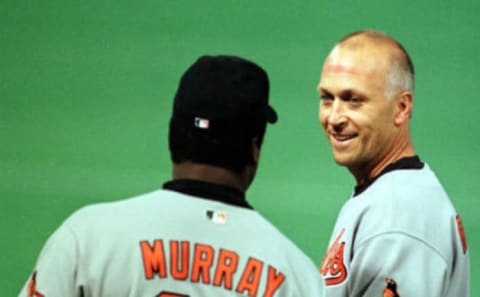
1988 Baltimore Orioles (54-107, .335)
This Baltimore Orioles team had the requisite star power one associates with the 1980s O’s. Cal Ripken, 27, Eddie Murray, 32, and Mike Boddicker, were all in their primes. Veteran Fred Lynn provided outfield stability.
Yet somehow things never came together in 1988. Quite the opposite, the Orioles opened with an astonishing 21-game losing streak, prompting the firing of manager Cal Ripken, Sr. They were 19 and one-half games out of first place by mid-May. In 44 games – more than a quarter of their full schedule – the Orioles scored one run or none.
For the entirety of the season, the 1988 Baltimore Orioles were bad in every way it is possible to be bad. They batted an AL-worst .238, 21 points below the league average, scored just 3.42 runs per game – more than a run below the average – and compiled a 4.54 earned run average, also the league’s worst.
Boddicker was a particular victim of the team’s collapse. Although compiling a commendable 3.86 earned run average in 21 starts, he won just 6 times, losing 12 before being traded to the Red Sox for a pair of up-and-comers, Brady Anderson and Curt Schilling.
In some cases, teams allow themselves to get very bad in a deliberate attempt to compile draft picks and improve quickly. But that was not the case with the 1988 Orioles. They did not play a post-season game until 1996, and did not win a divisional title until 1997.
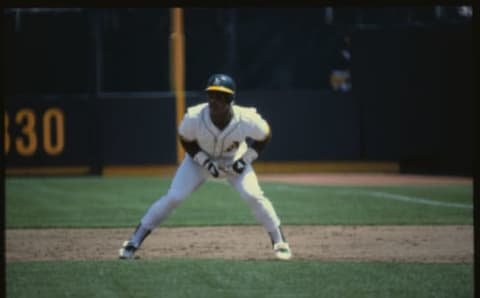
1979 Oakland Athletics (54-108, .333)
With three consecutive World Series championships, the A’s were the dominant team of the 1970s. By 1979, though, owner Charles O. Finley was broke and desperate to sell out. As with Wayne Huizenga and the late 1990s Marlins, his strategy until that could be accomplished was straightforward: trade or sell all of his best players in order to stay financially afloat.
The departures, via free agency, sale or trade, included the familiar rotation of Catfish Hunter, Ken Holtzman, Blue Moon Odom and Vida Blue, star reliever Rollie Fingers, and the heart of the world championship lineup, Reggie Jackson, Sal Bando, Gene Tenace, Bert Campaneris and Joe Rudi.
In their place, the A’s featured a lineup of neophytes. Some, among them rookie outfielder Rickey Henderson, Dwayne Murphy, Tony Armas and Mike Norris, would go on to become front-line contributors…and in Henderson’s case a Hall of Famer.
But 1979 was a year of learning. It began with five straight losses and nine in the team’s first 10 games. In those nine losses, the Athletics were out-scored 51-16. At least nobody showed up to see the carnage. Oakland’s opening day audience of just 10,387 was the largest in its first 14 home games, and never did the team draw as many as 20,000 to the Oakland Coliseum.
At more than 60 of the team’s 81 home dates, the A’s played before fewer than 5,000 fans, the low point coming on April 17 when just 653 showed up to watch their heroes defeat Seattle 6-5. The win moved Oakland’s record to 3-9.
Finley finally managed to sell the team – to Walter Haas – in 1980. Haas turned operational control over to Billy Martin, and by 1981 the Athletics had the American League’s best record.
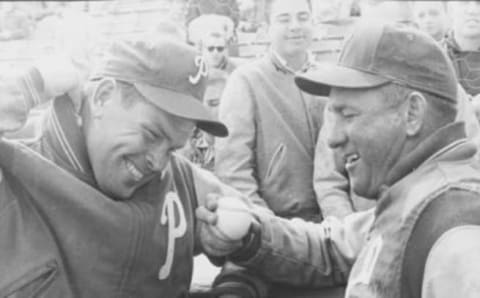
1961 Philadelphia Phillies (47-107, .305)
With their 40-120 record and .250 winning percentage, the 1962 expansion Mets are justifiably famed for their ineptitude. The 1961 Phillies weren’t that bad…but they also weren’t an expansion team.
In reality, 1961 was a culmination of putrid baseball in Philadelphia. The Phillies finished 47 games out of first and 17 games out of 7th, but that was nothing new; they had finished last in 1960, 1959 and 1958.
Gene Mauch, in his first full season as Philadelphia’s manager, had little in the way of talent to work with. Robin Roberts was on hand, but at 34 he was a shadow of the “Whiz Kid” who had led the 1950 Phils to a pennant. The leading offensive threat, outfielder Tony Gonzalez, batted .277 but his 118 hits included just 36 for extra bases. Indeed, the Phillies lacked much long-ball punch at all. They managed just 185 doubles and 103 home runs, both National League lows.
On the night of July 29, the San Francisco Giants beat Don Ferrarese 40-3, dropping the Phillies to 30-65. The next day, San Francisco beat Jim Owens 5-2. And so it continued, game after game, week after week. When they returned home to lose 3-1 to the Pirates Aug. 7, that made 10 straight losses.
The streak hit 15 on Aug 12 when the Pirates shut them out 4-0, and 20 games five days later in Milwaukee. That loss was especially galling because Philadelphia led 6-4 entering the bottom of the 8th. But Joe Adcock’s two-run home run tied the game, and the Braves won in the 11th thanks in part to an error by Phils third baseman Lee Walls.
The streak finally ended at 23 straight, making it the longest uninterrupted run of failure in the 20th Century.

1952 Pittsburgh Pirates (42-112, .273)
How could a team featuring Ralph Kiner coming off five consecutive 40+ home run seasons be so bad?
One look at the talent surrounding Kiner tells the tale. Indeed, the Pirates had some future baseball “greats” in their lineup…they just weren’t great at actually playing baseball. The catcher was Joe Garagiola, a future Hall of Fame broadcaster, but just a so-so hitter. The first baseman was Tony Bartirome, a rookie .220 hitter who would go on to become a nationally recognized trainer for the 1960s-1980s Pirates.
The shortstop was Dick Groat. In the 1960s, Groat would lead two teams to World Series wins. In 1952, however, Groat was just a 21-year old bonus baby fresh out of Duke University.
Surrounded by such a cast, Kiner did what he could. He hit 37 home runs and drove in 87, that total doubtless held down by the paucity of runners on base when he came up to hit. The Pirates batted just .231, 22 percentage points below the league average, and the entire roster other than Kiner managed just 55 home runs. On the mound, Pittsburgh wasn’t much better, compiling a 4.65 staff ERA that was last in the league by two-thirds of a run.
The story is famously told of Kiner’s confrontation with general manager Branch Rickey following the season’s end. Kiner had been paid $90,000 and protested Rickey’s plan to cut him to $65,000 for 1953. The veteran GM was having none of Kiner’s case. “Son, we could have finished last without you,” he told the team’s star. In June of 1953, Rickey traded Kiner to the Cubs.
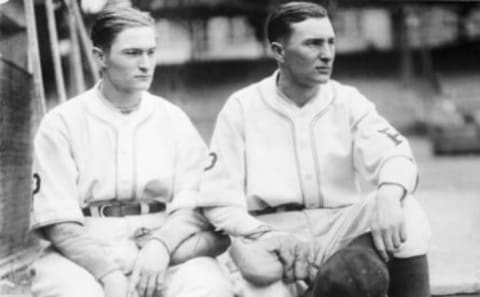
1942 Philadelphia Phillies (42-109, .278)
It’s not like World War II hurt the Phillies. They were already terrible.
The Phils had finished last annually since 1938, never winning more than 50 games. So it was no surprise when the team, with a veteran cast of carryovers from 1941, found itself buried in last place at 14-32 by the end of May. The Phils played 35 games decide by more than five runs and lost all but 3 of them.
Between Aug. 26 and Sept. 7, the Phillies lost 13 straight games in which they were outscored 78-31. Only one of those games was decided by one run. In a move that proved indicative of the team’s desperation, the Phils in December of 1941 signed free-agent outfielder Lloyd Waner, who had been released two months earlier. Waner had been a key figure on the Pirates’ last National League championship team, but that had been more than 14 years in the past. With Philadelphia, the 36-year-old Waner batted .261 with no home runs and just 10 RBIs.
But that was typical of the Phillies, whose home run and RBI leader, outfielder Danny Litwhiler, hit just 9 long balls and drove in just 56. For the season, the Phillies scored just 394 runs, 121 fewer than any other team. The lack of support showed up on the mound, where Rube Melton and Si Johnson combined to lose 37 games despite ERAs of 3.70 and 3.69 respectively.
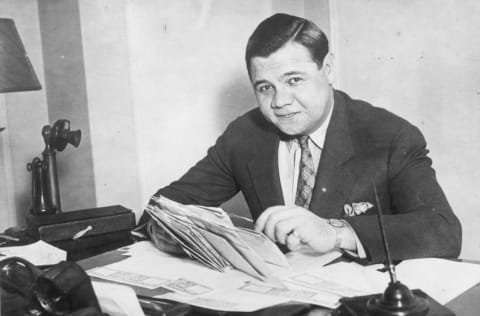
1935 Boston Braves (38-115, .248)
Judge Emil Fuchs had owned the Braves for more than a decade, and it had been a desolate one. As an owner, his career .409 winning percentage included three previous 100-loss seasons, although the previous three, 1932 through 1934, were his three best.
That streak ended in 1935 when the Braves fell from 78 victories and a credible fourth place showing to just 38 wins and a solid last, 26 games out of 7th place.
The Braves had one legitimate star, outfielder Wally Berger, and he was a good one. Berger hit 34 home runs and drove in 130 runs with a .548 slugging average. But there was no backup for Berger; none whatsoever. The rest of the Braves hit just 41 home runs and drove in just 414. The team runner-up in home runs was a fellow you may have heard of: Babe Ruth. Signed by Fuchs prior to the season for what amounted to a farewell tour, the 40-year-old slugger played in just 28 games before retiring at the end of May. But he did manage six home runs.
Members of the pitching staff competed daily with one another to see who was least competent. Ben Cantwell went 4-25 in 39 appearances, but at least he could point to a 4.61 ERA that was acceptable by the lively ball standards of the day. Ed Brandt, Danny MacFayden, Huck Betts and Bob Brown combined for 74 starts, none of them keeping their ERAs below 5.00. The staff allowed 852 runs, an average of more than 5 and one-half per game.
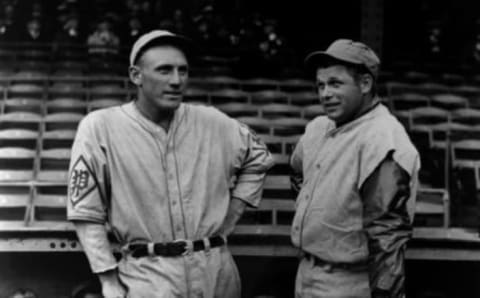
1928 Philadelphia Phillies (43-109, .283)
The 1942 Phillies may have been the worst team in franchise history, but the 1928 version would have given them a good game. Or perhaps “a bad game” would be a more accurate generalization.
In 1928, the Phillies’ pitching staff delivered a 5.68 earned run average, more than a run and a half above the league’s 3.99 ERA. Only one regular starter, Ray Benge, managed an ERA below 5.30. On 27 different occasions, Phils pitchers surrendered 10 runs or more runs. During a 5-game stretch in late July and early August, the Phils pitchers allowed opponents 75 runs, an average of 15 runs per game.
The Phillies also had a particular knack for coming up small in close contests. Their record in one-run games was 16-35.
At least the Phillies could hit. Rookie outfielder and future Hall of Famer Chuck Klein batted .360 following his mid-season acquisition. Third baseman Pinky Whitney drove in 103 runs.
Unlike most truly awful teams, the 1928 Phillies enjoyed one brief moment in the sun, albeit a fleeting one. Coming to the field at just 7-34 on June 7, Benge pitched a six-hitter and Philadelphia beat the Chicago Cubs 4-2. The next day they did it again, this time 6-5 on an eighth-inning comeback. Those games touched off a stretch of 13 games through June 28 in which the Phillies went 10-3.
For the rest of the season, they were 33-106.
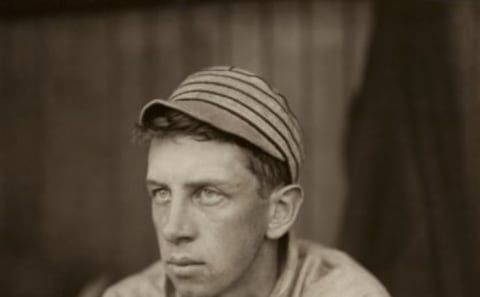
1916 Philadelphia Athletics (36-117, .235)
Afraid of losing the stars of his four times in five seasons American League champions to the new Federal League, Connie Mack chose instead to sell off as many of those still-useful parts as possible. Eddie Collins, Chief Bender, Eddie Plank and Home Run Baker all either jumped to the Feds or were dealt to teams capable of paying them more competitively. By 1916, only first baseman Stuffy McInnis and pitcher Joe Bush remained from the glory days.
The result was one of the memorably bad teams of all time.
How bad? This bad. In 1916, six American League teams finished at .500 or better, while a seventh, the Washington Senators, went 76-77. The Athletics finished 40 games behind Washington, nearly three times as far from seventh place as the Senators were from first place.
The numbers told Philadelphia’s story. The Athletics averaged just 2.9 runs per game, nearly a half run less than every other team…and that in the dead ball era. They had the league’s worst batting average, the fewest hits, and the worst on base average.
On the mound, things were no better. In an era when the average ERA was 2.82, A’s pitchers allowed nearly 4 earned runs per game. They allowed 776 runs, 174 more than any other team, and committed 314 errors, making nearly 200 of those runs unearned.
So desperate was Mack for talent that Napoleon Lajoie held down second base. A future Hall of Famer, Lajoie had batted .422, still the American League record, for the 1901 Athletics before being sold to Cleveland, where he compiled a .338 career average with five batting titles. By 1916, however, Lajoie was past 40 and reduced to a .246 shadow of his former self.
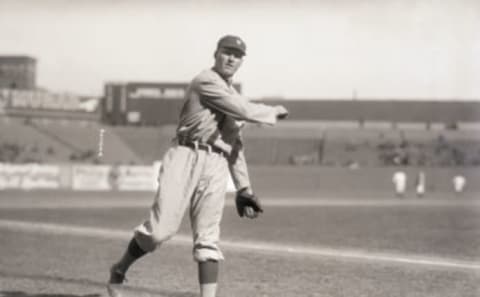
1909 Washington Senators (42-110, .276)
To appreciate the futility of the 1909 Senators, one need only consider the case of Walter Johnson.
A 21-year-old third-year fireballer, Johnson made 36 starts for the Senators, compiling a 2.22 ERA over 296 innings of work. In those 296 innings he allowed just 112 runs and walked just 84, leading to a 1.11 WHIP. Based on those numbers, what do you suppose Johnson’s 1909 record was?
The answer: 13-25. Eleven of those losses came in games in which Johnson allowed three or fewer runs, and eight of the 11 were by shutout.
In short, the Washington offense was incompetent, even by dead ball standards. The Senators scored just 382 runs, fewer than 2.5 per game. The team’s OPS+ — that’s the park-adjusted figure compared to the league average of 93 – was just 77.
Of the eight regulars in Washington’s lineup, only two – outfielders George Browne and Jack Lelivelt – produced averages above the league’s .244 standard. The team RBI leader, Bob Unglaub, drove home 41.
The Senators were a presentable 19-30 in mid-June when true futility set in. Through early August, they won only seven of their next 47 games, Johnson claiming three of those. After a 4-2 week, they lapsed into a second skid, losing 20 of 23 through early September.
Johnson, of course, shrugged off the perennial misfortune, going on to win 414 games. The 1909 season also marked the last time during Johnson’s 21-year tenure with the Senators that they would finish in the league cellar. In fact, they finished second in both 1912 and 1913, although waiting until 1924 to emerge with that long-sought World Series victory.
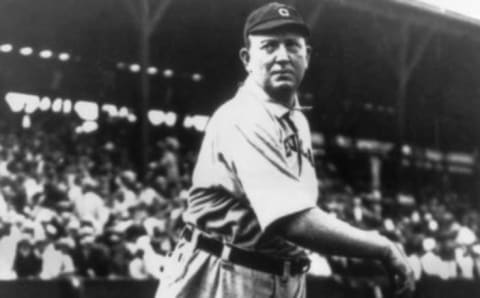
1899 Cleveland Spiders (20-134, .130)
The Spiders were owned by the Robison brothers, Frank and Stanley, who simultaneously owned the St. Louis franchise. When the Robisons got crosswise with the local and state governments in 1897-98 over the playing of Sunday baseball in Cleveland, they retaliated by transferring all of their quality players to St. Louis.
This was not inconsequential given that the Spiders roster included such luminaries as Cy Young. In 1899, Cleveland fans were left to watch the dregs of two franchises fumble and stumble through what was probably the worst season in professional sports history in America.
The Spiders lost seven of their first eight games, five by margins of seven runs or more. Their longest winning streak all season was two games, and they went 24 games from August 26 to September 17 without winning a single game. That remains the longest losing streak in baseball history.
Attendance in response to the Spiders’ fiasco was so bad that the team basically quit playing home games altogether in early July. Instead, the Robisons shifted all but 10 of Cleveland’s final 43 home games to the road due to lack of fan interest. As a result, the Spiders played just 44 home games all season against 110 games at foreign sites.
More from Call to the Pen
- Philadelphia Phillies, ready for a stretch run, bomb St. Louis Cardinals
- Philadelphia Phillies: The 4 players on the franchise’s Mount Rushmore
- Boston Red Sox fans should be upset over Mookie Betts’ comment
- Analyzing the Boston Red Sox trade for Dave Henderson and Spike Owen
- 2023 MLB postseason likely to have a strange look without Yankees, Red Sox, Cardinals
With a .286 average, second baseman Joe Quinn was the team’s leading hitter. Naturally the Spiders were last in the 12-team National League in both batting average and runs scored, an eye-catching 212 runs behind the 11th place Giants in runs scored.
But it was on the mound where the Spiders stood out. They allowed 8.13 runs per game, 269 more runs than the next worst staff. Jim Hughey, a veteran exiled from St. Louis, went 4-30 in his 34 starts his four victories leading the team.
When the 1899 season ended, National League owners voted to consolidate from 12 teams to eight. The Spiders were the first team culled from the league’s ranks.
Next. Top 20 CF in MLB History. dark
We hope you have enjoyed this look back through the decades on the worst teams of each decade. We will see by the end of the season if the Baltimore Orioles or Kansas City Royals join them!